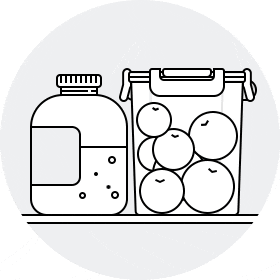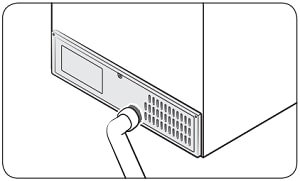Why does ice form on the bottom of my Samsung freezer?
Ice can form on the bottom of freezers for a few reasons. The most common are humid air entering the freezer, faulty door seals and poor ventilation. To prevent ice from building up, try the solutions below to resolve your issue.
If you're looking for information about your specific appliance, please refer to your user manual. You can find your user manual by visiting Samsung Support and entering your model number. Find out where the model number and serial number is on your refrigerator.
Ensure that the door is closing completely and that nothing is resting against the back wall of the freezer.
Make sure that the door seal on the edge of the door is attached properly. You can check this in two ways:
- pass your hand around the edge of the door to see if you can feel any cold air escaping
- place a sheet of paper into the door, then try to pull it out. If you can pull the sheet out without any resistance the doors are not closing properly
It may help to clean the door seal by wiping them with warm soapy water and a clean cloth. If you find that the door seal isn't functioning correctly, or is ripped or torn, it will need to be repaired or replaced.
If your refrigerator is in direct sunlight the temperature may increase, making the device work harder to cool. This can cause a build-up of frost and other temperature issues. If possible, prevent direct sunlight from shining on your fridge.
Similarly, if your refrigerator is close to a heat source like a radiator or an oven, it will have to work harder to stay cool. Place your appliance away from external heat sources.
It is recommended that your refrigerator is kept in a room where the temperature is between 10ºC and 38ºC.
If your home is humid, simply opening the freezer door can cause ice to build up. As you open the freezer door, warm and humid air rushes in and begins to freeze. Try and avoid leaving the freezer door open or opening it unecessarily.
If the ventilation is blocked or inhibited, then cool air will not circulate properly in the freezer. To allow for the best circulation, items in the freezer should be spread out as much as possible.
Check the air vents on the freezer. Clear or move away anything that is blocking the vents.

Keeping the rear of your refrigerator clean from dust and debris can also help prevent ice build up. It is recommended that the rear panel is hoovered once or twice a year.
Please note: do not remove the rear panel cover as electric shock may occur

Warm and hot food raises the humidity in the freezer and can cause ice to form. Allow food to cool completely before putting it into the freezer.
If your freezer has an ice maker, it could be allowing warm air to enter. Ice makers have a flap that prevents cool air from exiting the freezer while also keeping warm air out. Open your freezer and examine the ice chute. There should be a flap of material that will be flush against the housing. If the flap is not sitting flush, check for any ice or debris that may be blocking it.
If there's a lot of ice in your freezer, you should defrost it and remove any build-up of frost and ice.
If ice continues to form at the bottom of your freezer despite verifying that the door seals properly and that ventilation is adequate, please contact Samsung Support to resolve your issue.
Thank you for your feedback!
Please answer all questions.